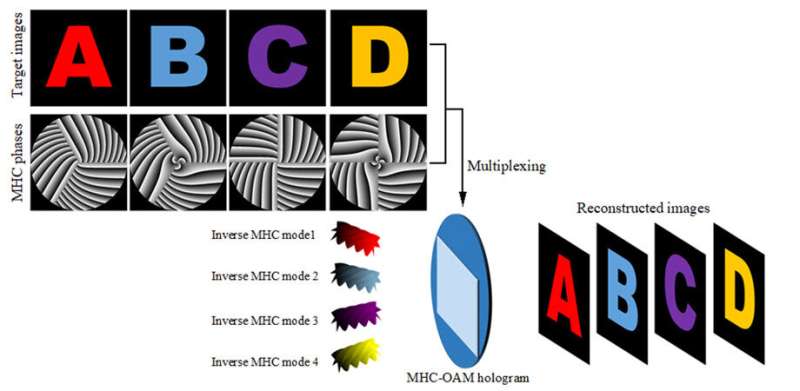Orbital angular momentum boosts multiplexed holography


Optical holography is a powerful method for recording and reconstructing complete optical field information, including intensity and phase. It has found extensive applications in various fields, such as optical display, imaging, data storage, encryption, and metrology. With the rapid development of the information society, the need for increased coding freedom to meet high-security and high-capacity challenges has become apparent.
While different physical dimensions of light, such as wavelength, angle of incidence, polarization, and time, can serve as independent information channels in holographic systems, the availability of spatial channels is limited. After exhausting the available physical dimensions for multiplexed holography, researchers have found new opportunities in the orbital angular momentum (OAM) dimension of light.
By sampling holograms appropriately in momentum space, researchers have implemented OAM as an independent information carrier for optical holography, leading to OAM multiplexed holography. This technique offers unprecedented optical information processing capabilities due to the infinite spiral modes and inherent orthogonality of OAM.
To further enhance holographic multiplexing, researchers from Soochow University in China recently proposed a new approach called multiramp helical conical OAM (MHC-OAM). As reported in Advanced Photonics Nexus, this approach uses a spatial light modulator (SLM) to achieve MHC beams with different parameters that can serve as information encryption or decryption channels, significantly expanding the capability of holographic multiplexing.
Relying on independently modulated MHC beam parameters, the design allows for spatially arbitrary MHC beam waveforms and different types of MHC-OAM holography. In addition to the topological charge contributed by OAM, three other parameters can serve as carriers for information encoding and decoding: the number of multiramp mixed screw-edge dislocations, the normalized factor, and the constant of the MHC beam.
Combining the four parameters of the MHC beam differently can result in higher dimensional holographic multiplexing, with the benefit of improved security.
The multidimensional MHC-OAM hologram provides additional security keys, enabling the development of advanced nested optical encryption platforms. This innovation revolutionizes existing optical encryption schemes with limited data capacity or low security. By using MHC-OAM holograms to encrypt and decrypt optical information based on specific MHC modes, the encoded information becomes impervious to certain brute force attacks.
The optical encryption scheme offers theoretically unlimited information channels, meeting growing demands for parallel high-security information transmission.
According to Prof. Xiao Yuan, principal investigator at Soochow University’s Key Laboratory of Advanced Optical Manufacturing Technologies, “The generic design approach of MHC-OAM multiplexed holography can be extended to achieve holographic multiplexing in higher dimensions, such as by combining the polarization and wavelength of light. This opens new possibilities for further enhancing information capacity and security in optical holography.”
With the potential for unlimited information channels and impervious encryption, optical holography continues to evolve and meet the demands of the information age.
More information:
Nian Zhang et al, Multiparameter encrypted orbital angular momentum multiplexed holography based on multiramp helicoconical beams, Advanced Photonics Nexus (2023). DOI: 10.1117/1.APN.2.3.036013
Citation:
Orbital angular momentum boosts multiplexed holography (2023, July 5)
retrieved 5 July 2023
from https://phys.org/news/2023-07-orbital-angular-momentum-boosts-multiplexed.html
This document is subject to copyright. Apart from any fair dealing for the purpose of private study or research, no
part may be reproduced without the written permission. The content is provided for information purposes only.
For all the latest Science News Click Here
For the latest news and updates, follow us on Google News.

